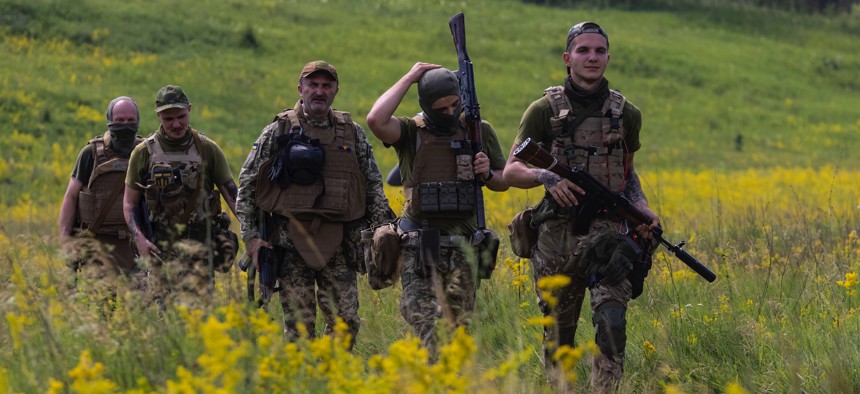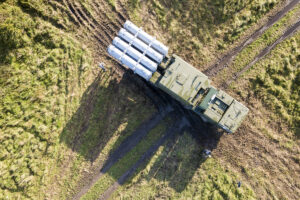On 10 February, 2023, the Stimson Center convened the seventh virtual meeting of its US-Russia Military-to-Military Dialogue.
The meeting started with the opening remarks by Brian Finlay, Stimson’s President and CEO, and was moderated by Stimson senior staff members: Bruce McConnell, Distinguished Fellow; Vladimir Ivanov, Adjunct Senior Fellow; and James Siebens, Fellow.
American participants in the meeting included General (ret.) George W. Casey, General (ret.) Curtis M. Scaparrotti, Ambassador Karl W. Eikenberry and General (ret.) John P. Abizaid. Russian participants included Lieutenant General (ret.) Evgeny P. Buzhinsky, Major General (ret.) Vladimir Z. Dvorkin, and Major General (ret.) Pavel S. Zolotarev.
The participants were joined by four experts, each specializing in a specific topic related to the discussion.
The experts included: Samuel Charap, Senior Political Scientist at the RAND Corporation; Olga Oliker, Program Director, Europe and Central Asia, Brussels, at Crisis Group; Andrei Zagorski, head of the Department of Disarmament and Conflict Resolution Studies at IMEMO of the Russian Academy of Sciences; and Oleg Krivolapov, Senior Research Fellow at the Center for Military-Political Researches at the Institute for the US and Canadian Studies of the Russian Academy of Sciences (ISKRAN).
The participants discussed possible battlefield scenarios in Ukraine, the prospects and likely preconditions for a ceasefire, as well as broader tensions between Russia and the US/NATO in the context of an evolving strategic stability agenda.
Participants agreed that:
- From the military perspective, the most important immediate common goals are to end the hot phase of the conflict, and to prevent it from expanding beyond its current geographic boundaries.
- It will not be easy to reach a ceasefire on conditions that would satisfy both parties, as neither side will accept defeat, and neither side is satisfied with current conditions.
- There is high likelihood that the conflict will continue, and the war of attrition will go on. It is also hard to predict the final outcome of the war, hence formulating a long-lasting solution doesn’t seem to be realistic at the moment.
- Developing sustainable parameters of a new European security framework will become possible only after the end, and based on the outcomes, of the military phase of the conflict in Ukraine.
- Participants suggest that the US and Russian governments resume the activities of the Bilateral Consultative Commission (BCC) under the New START to discuss next steps in securing sustainability of the Treaty and future strategic stability.
A new security order in Europe: too early to design?
- American participants believe that Russia made a significant miscalculation as to both Ukraine’s ability to defend itself as well as to the scope of NATO support to Ukraine. The Russian participants believe that it will not be possible to inflict a “strategic defeat” on Russia in expectation that it will deplete its resources. Drawing Russia into a war of attrition would risk an escalatory shift in its military-political goals.
- The Russian side flagged the danger that if fighter jets are supplied to Ukraine, then the dimensions of the conflict will change, and it may spill over outside Ukraine.
- Russia and the West are not likely to restore the relations they had prior to the beginning of the Ukraine military conflict any time soon, according to Russian participants. Instead, a long-term confrontation should be expected, with both camps trying to ensure their respective security conditions, followed by high probability of a new arms race. At the same time, it was noted that reaching a durable ceasefire may open doors for positive political dynamics creating new opportunities for sustainable peaceful solutions.
- Participants and experts noted that the war catalyzed the breakdown of the regional order and any outcome of the Ukraine conflict will have an impact on regional security, beyond Russia-Ukraine bilateral relations. Therefore, it is important not only to make efforts to end the fighting but also to ensure that the final settlement has a long-term effect with a durable ceasefire and a broader positive impact on regional security.
- Discussion of possible immediate steps towards a ceasefire led to a suggestion that the only visible near-term chance would be through involvement of one or a group of influential global players (e.g., China, India, United States) under a UN mandate, as principal mediators.
Preserving the New START and future strategic stability
- Expert discussion of the prospects of New START upon its looming expiration revealed prevailing skepticism about the chances of reaching a comprehensive bilateral treaty or an executive agreement if the current escalatory trend in US-Russia relations continues. However, experts noted some positive sectoral policy developments, providing hope for a set of interconnected agreements and unilateral steps to regulate particular classes of weapons, both nuclear and non-nuclear. It was mentioned that in its 2022 Missile Defense Review the U.S. for the first time officially recognized the threat posed by non-nuclear strategic weapons to U.S. territory, introduced a provision on transparency in missile defense, and emphasized interrelationship between strategic offensive arms and strategic defensive systems. This is a major change in the U.S. approach, opening opportunities for harmonizing Russian and American approaches to strategic arms limitations.
- One of the Russian participants noted that military use of space and missile defense should be considered as separate issues at the negotiation table. He also highlighted a past suggestion of safe conduct in the outer space, but mentioned that the sides can make progress only if the relationship improves.
- China’s growing nuclear and missile potential was flagged as a visible factor leading to shifts in strategic stability equation. Involving China in strategic arms limitation agreements will be a challenging task, although not the most pressing at the moment. Participants emphasized that the critical first step in sustaining global stability on this issue must be led by the United States and Russia, the most powerful nuclear states responsible for securing further progress of nuclear arms control and non-proliferation regimes.
The US-Russia Military-to-Military dialogue is made possible by the generous support of Carnegie Corporation of New York. The project was initiated by the EastWest Institute in 2020 and transferred to the Stimson Center in 2021.



